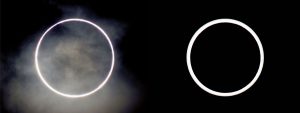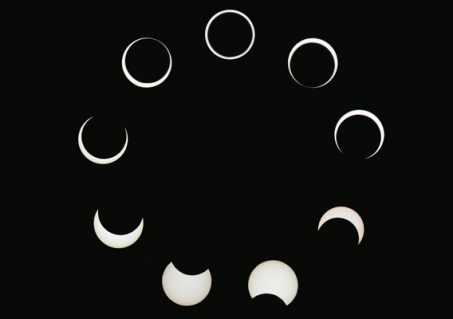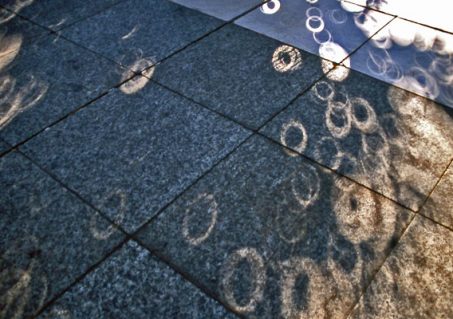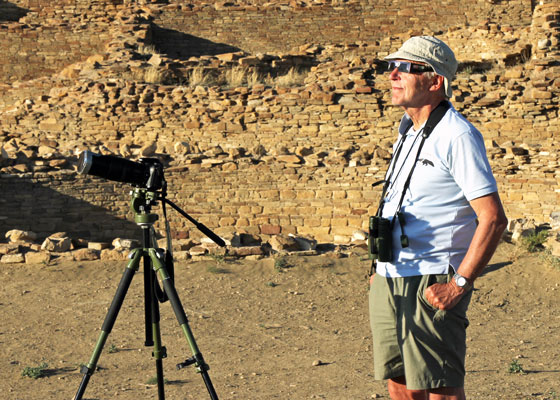A total solar eclipse gets the most attention from eclipse chasers, but an annular solar eclipse is also an extraordinary celestial event, and it comes with its own set of unusual circumstances. (In addition to total and annular eclipses, there are also hybrid and partial eclipses. For more details, go to our blog that describes the different “Types of Solar Eclipses.”)
Simply put, annular eclipses occur when the new Moon passes across the face of the Sun, but never completely hides the solar disk. At mid-eclipse (annularity), there is always a ring of brilliant sunlight surrounding the Moon. Indeed, the word ‘annular’ derives from medieval Latin ‘annularis,’ which means ‘pertaining to a ring.’
But why is it that when the Moon crosses the middle of the solar disk, it sometimes completely covers the Sun, while at other times it doesn’t? It’s all about changing distances between the Sun, the Moon, and Earth.
The Sun is roughly 400 times farther from Earth than the Moon, and it’s also about 400 times larger than Luna. This means that, on average, the Moon and Sun appear to be almost the same size (apparent diameter) in the sky. But the word ‘average’ is the key. The Earth’s orbit around the Sun is elliptical, as is the Moon’s orbit around Earth. So the distance between these three bodies is constantly changing, which means their apparent diameter is also constantly changing.
Consider the consequences of two orbital extremes. When Earth’s orbit takes it farthest from the Sun, and the Moon’s orbit draws it closest to Earth, the apparent diameter of the Moon is larger than the Sun’s. This means the Moon can completely cover the solar disk and, at mid-eclipse, the result is totality.
On the other hand, when Earth is closest to the Sun and the Moon’s orbit takes it far from Earth, the Moon’s apparent diameter is smaller than the Sun’s. Consequently, the Moon appears too small to completely cover the solar disk and, at mid-eclipse, a brilliant ring (annulus) of sunlight surrounds the Moon. This leads to the nickname “Ring of Fire” for annular eclipses.
The duration of annularity varies tremendously, and it all depends on the locations of the Moon and Earth in their respective orbits. At one extreme, when the apparent diameters of the Moon and Sun are almost equal, annularity can last for a second or less (as it did on May 9, 1948). At the other extreme, with the Moon farthest from Earth and the Sun at its closest, annularity of more than 12 minutes is possible, though this won’t happen again until January 3080.

Solar eclipses (of any kind) can take place only during the new Moon phase. But while there’s a new Moon every month, we don’t see monthly eclipses. That’s because the Moon’s orbit is tilted by 5° to the plane of the ecliptic—the name for the Sun’s apparent path around the sky as seen from Earth. More often than not, the new Moon passes above or below the Sun, and the lunar shadow misses Earth completely.
But every 173.3 days, the new Moon passes through one of two crossover points called nodes, where the Moon’s tilted orbit intersects the ecliptic. Here, at last, a solar eclipse is possible, be it partial, total, or annular. But the complications don’t end there. Those nodes slowly shift westward, which means the months in which eclipses take place slowly change as the years pass. This also affects when different types of eclipses occur. At the moment, long annulars are more likely in January; long totalities in July.
After 6,585 days (18 years, 11 days, 8 hours), the entire eclipse cycle repeats. This is called a Saros cycle. When two eclipses are separated by a period of one Saros, the Sun, Earth, and Moon return to approximately the same relative geometry, and a nearly identical eclipse occurs, though the path of the second eclipse will be shifted west by eight hours—one third of Earth’s rotation.
Of course, solar eclipses of all types occur more often than once every 18 years. Between 2020 and 2030, there are seven annulars and six totals, a decade-long ratio of annulars to totals that is close to the long-term average. Over a 5,000 year period, annulars comprise 55% of these two types of eclipses.


What is the difference between an annular and a total solar eclipse? The distinction is most obvious when the Moon and Sun are in perfect alignment. At this point during a total eclipse, the Moon completely covers the solar disk and the umbra, the dark lunar shadow, sweeps across Earth along a narrow path. As the sky darkens during totality, the corona, the Sun’s gossamer outer atmosphere, is revealed.
But during an annular eclipse, the Moon is too small to cover all of the brilliant solar disk and a ring of sunlight surrounds Luna. Observers in the path of annularity are standing in the antumbra, where the sky remains bright enough to hide the solar corona. This leads to a second major mid-eclipse difference. During annularity, safe solar filters covering eyes and cameras must remain in place at all times, whereas during the total phase of a total solar eclipse, these filters can be removed. In fact, during the entire annular eclipse, you can never look directly at the Sun without using solar filters.
While there are some events observers see during totality that aren’t visible during annularity, an annular has its own special charm. From beginning to end, much of the annular eclipse sequence is the same as for a total solar eclipse. It still takes more than an hour for the eclipse to proceed from first to second contact. The light still fades somewhat as the eclipse progresses.
As the Moon creeps across the Sun’s face, eclipse watchers often try to guess the point at which it becomes obvious that the eclipse is, indeed, annular. With solar filters firmly in place, observers can watch Baily’s Beads pop on and off at second and third contacts. And there is something very unsettling about seeing the Sun with a gaping hole in its midsection during annularity.
Just as we want clear skies for a total eclipse, we also want clear skies for an annular. With that in mind, TravelQuest’s eclipse meteorologist is involved in our site selection, directing us to a location along the track of annularity where the weather prospects look most promising. But one advantage annularity has over totality is that a little cloud will not obscure the spectacle. The left-most of the two images of annularity near the top of the page was shot through cloud, cloud that would have obscured many features of totality had this been a total eclipse. Our trip to Panama to see this particular annularity was quite an adventure, and very special. We hope you’ll join us for our next annular solar eclipse expedition.

Header image by Paul Deans/TQ
Keep Reading
Blog Archive